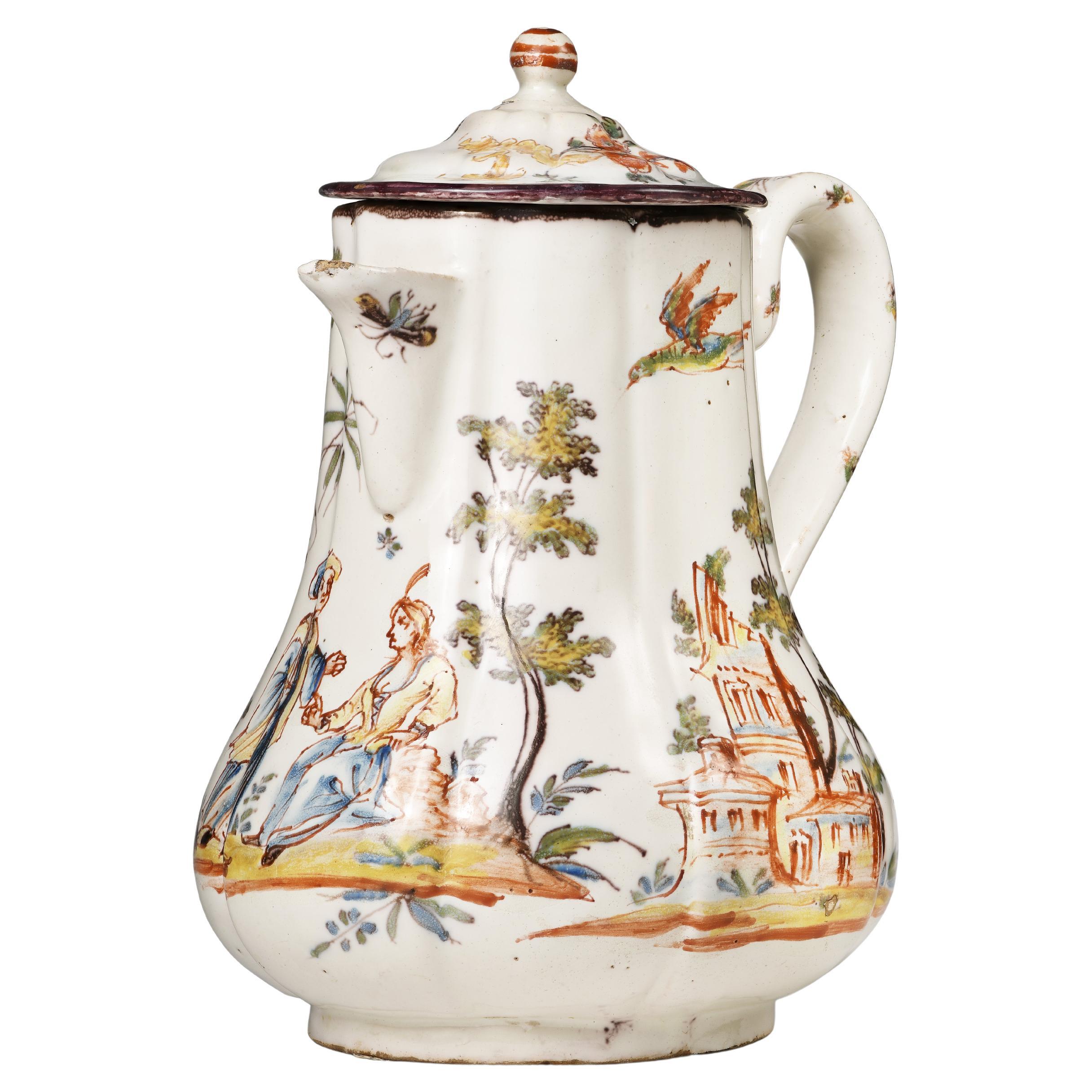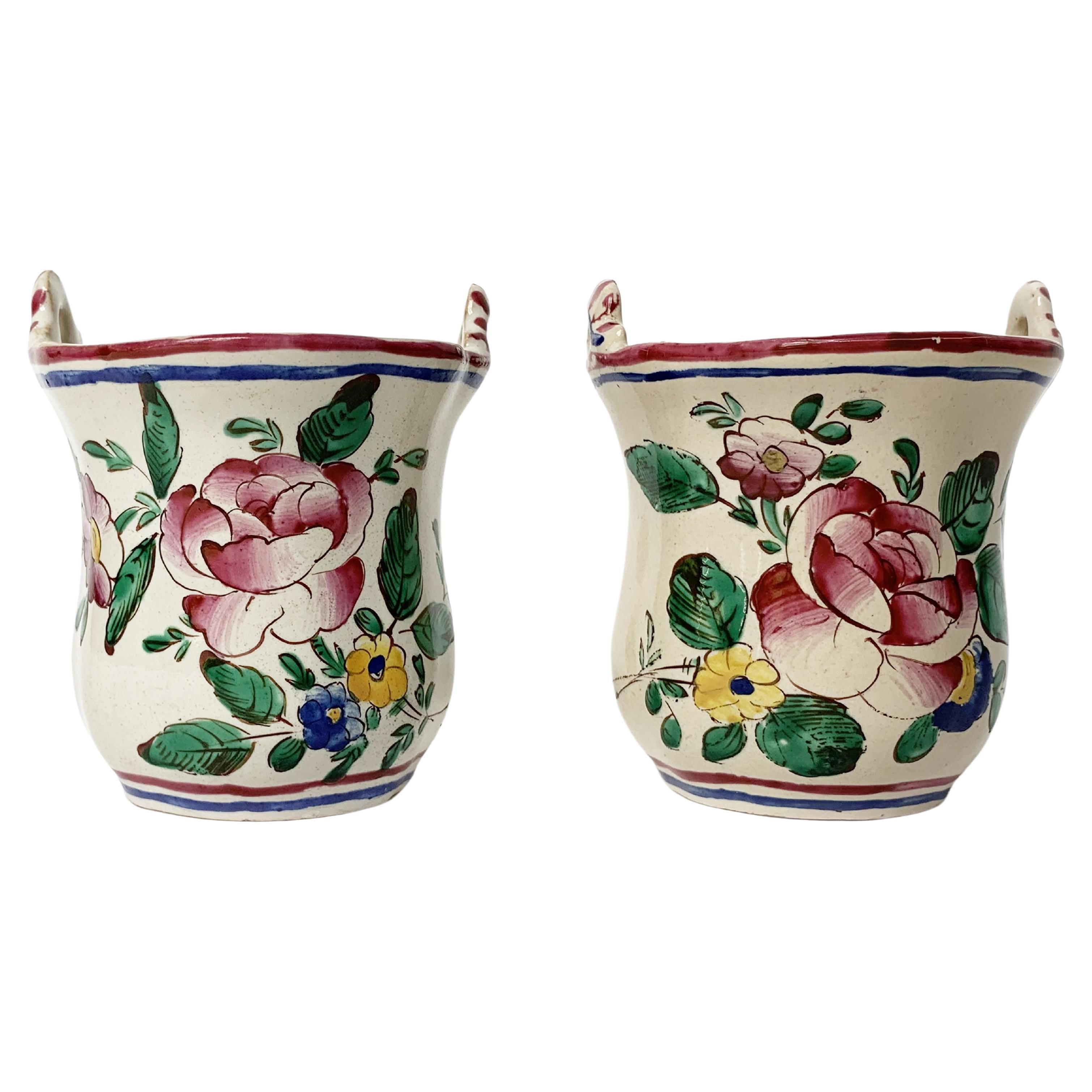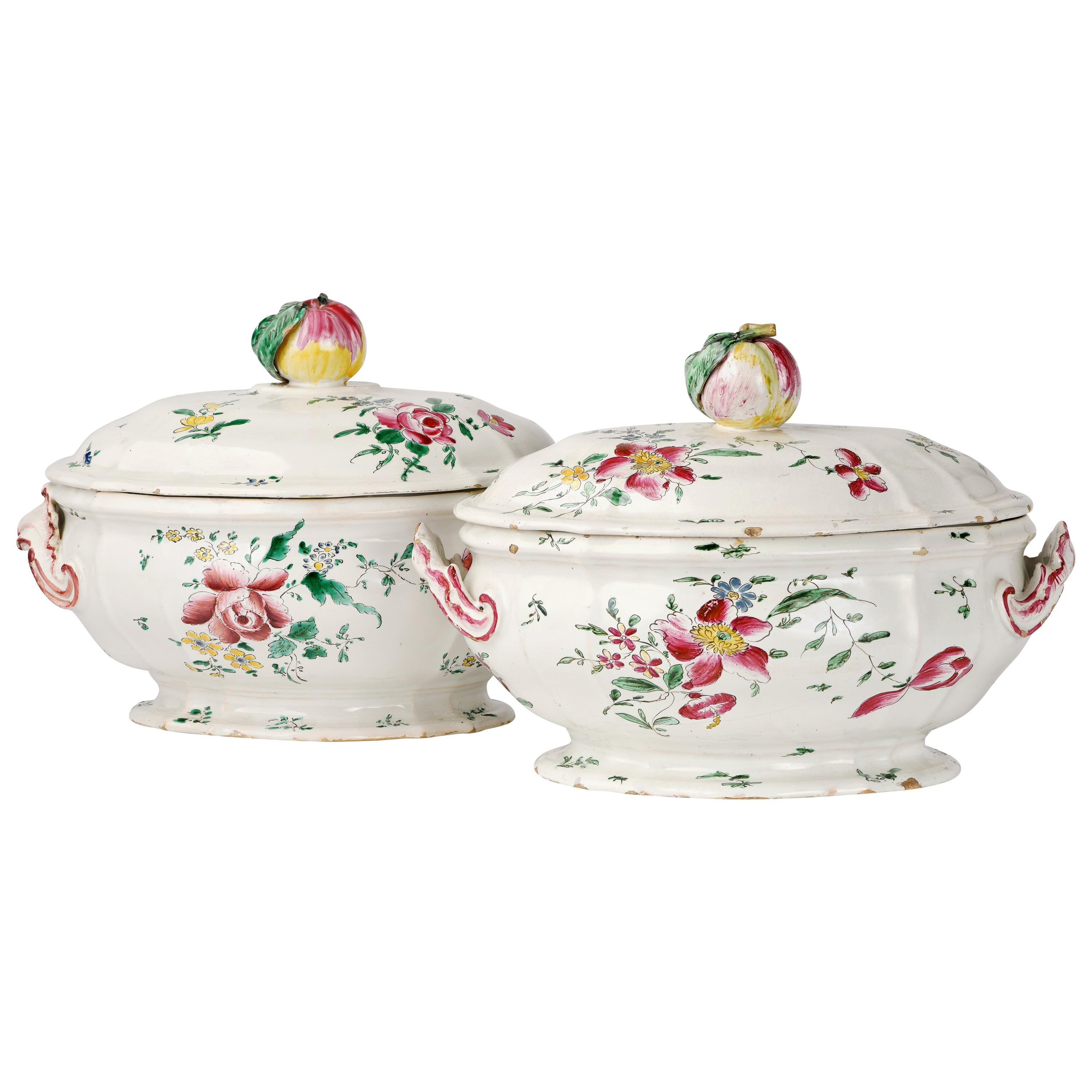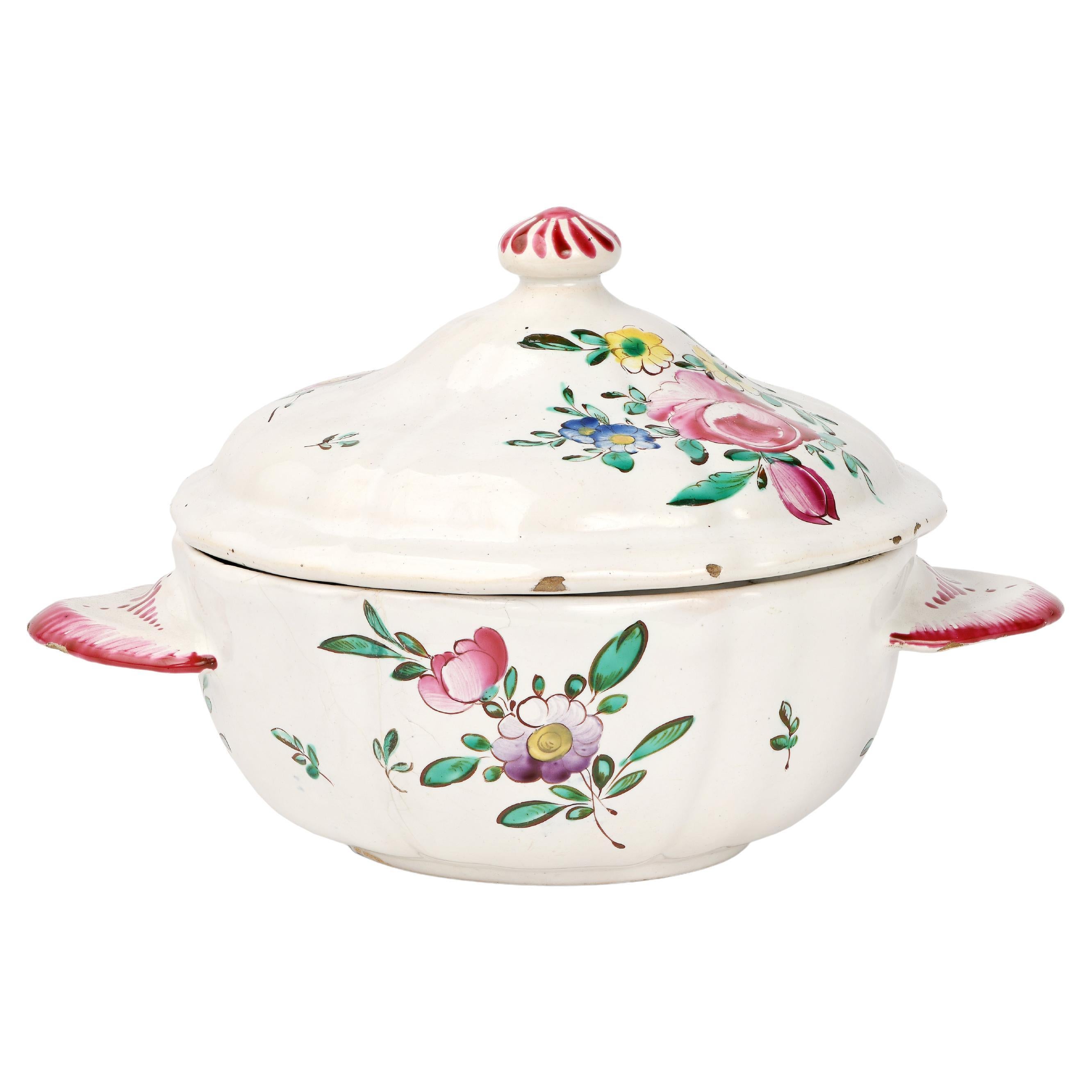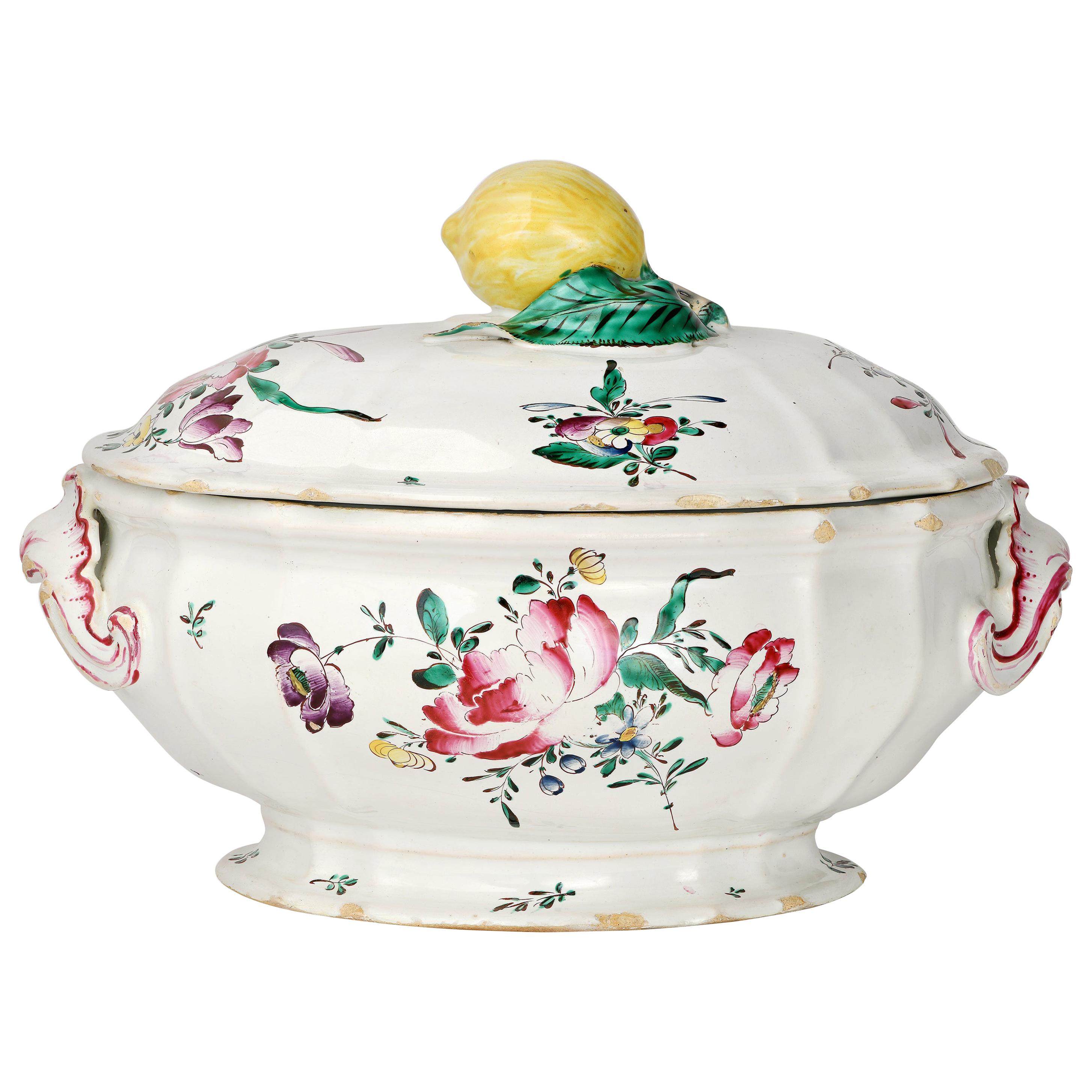Items Similar to Maiolica Pitcher Antonio Maria Coppellotti Manufacture, Lodi, Circa 1735
Video Loading
Want more images or videos?
Request additional images or videos from the seller
1 of 21
Maiolica Pitcher Antonio Maria Coppellotti Manufacture, Lodi, Circa 1735
About the Item
Majolica pitcher
Antonio Maria Coppellotti Manufacture
Lodi, circa 1735
Majolica decorated in cobalt blue monochrome
It measures 7.36 in hight x 8.07 x 4.52 (h 18.7 cm x 20.5 x 11.5)
Weight: 0.859 lb (390 g)
State of conservation: intact, apart from a slight chip on the tip of the spout due to use.
The maiolica pitcher has a mouth with a long triangular spout and a contoured, slightly flared rim that rises at the back where the handle is attached. The latter is carried high and consists of a flat-sectioned ridge that, from the attachment to the rim, traces a descending 'S' ending with a slight protrusion. The smooth and cylindrical vessel widens at the base to form a slightly lobed, rounded chalice, then it narrows into a stem and expands into a broad, ribbed, slightly flared, contoured foot with a concave base.
The surface is covered with a thick white glaze; the artistry of the painting is quick but precise and does not skimp on the use of the precious blue pigment. The decoration covers the entire surface, including the inner rim. On the front it features a flower with wide petals accompanied by a phytomorphic decoration that radiates with dense geometric arabesques, following the principles of the so-called "a lace" decoration inspired by the contemporary French decoration lambrequins et rayonnants or the Rouen style. The decoration interrupts at the cup, which is adorned with oval-shaped lobes, then resumes in the same manner on the foot, as in the Rouen style.
This pitcher accompanied the equipment of a complex eighteenth-century table setting and in theory functioned as a vessel for pouring liquids: It was coupled with a tub for washing hands, and was for pouring wine into glasses, not at the table, but rather with each glass poured and offered by dedicated waiters to each diner.
The small number of consistent works in terms of morphology, dimensions, and decoration, found in private collections, confirms the attribution of the small pitcher in question to the Lodi manufacture of Antonio Maria Coppellotti in its early phase around 1735-1740. See the two spouts or pitchers presented at the Lodi maiolica exhibition (M. L. Gelmini, in Maioliche lodigiane del '700, cat. mostra di Lodi, Milano 1995, pp. 76-77, nn 39-40) and the pouring spout, previously part of the Robiati collection, exhibited at the Poldi Pezzoli in 1964. (G. Gregorietti, Museo Poldi Pezzoli, Maioliche di Lodi, Milano e Pavia, Milan 1964, no. 32). A particularly similar work is preserved in a private collection in Lodi. (F. Ferrari, La ceramica di Lodi, Lodi 2003, p. 94, n. 4). The use of this same mold is also derived from jugs that bear different decorations, such as, for example, the two pitchers with 'fruit' decorations (Gelmini, op. cit., pp. 118-119, nos. 113-114), confirming the success of this form in the Coppellotti manufacture as documented in 1750.
Other published examples document the use of different molds in the manufacture, as evidenced by the morphology of other specimens that differ both in size and in the different characteristics of the vessel's shape, foot, or handle applied in a raw state. The execution of the decoration, similar to ours in design, remains different due to the different personalities of the painters themselves.
The examined work stands out from comparisons due to an intriguing distinctive characteristic of the form that, during the drying phase from the raw state, underwent a slight and unusual compression on the neck of the foot caused by the weight of the vessel: this 'defect' did not prevent, even in ancient times, the piece from leaving the manufacture, as it was not considered detrimental to the quality of the work. Indeed, this piece has come down to us with all its simple beauty still intact.
The first mention of the Coppellotti family as potters comes from archival documents which record the official request of an unknown Giovanni Coppellotti to open a majolica factory in Lodi in 1674.
The factory, located near the church of St. John the Baptist. Philip seems to have been immediately quite successful. However, it was only in 1679, when the management of the factory passed to Antonio Giovanni Maria Coppellotti - the son or perhaps grandson of the original Giovanni - that the production reached the peak of success and became an example for the main Italian manufactures of the time, especially those in Veneto and Liguria. In 1728 the factory had to move outside the city walls at the behest of the authorities, who feared the possibility of fires.
The activity continued until about 1750, the year of Anton Maria's death and resumed later with his son, Bassano Coppellotti, under the guide of some other directors, among whom we note: first, G. Moroni, followed by Giulio Berinzaghi and in 1771 Pedrinazzi. Finally, in 1787 a new municipal ordinance ordered the definitive closure of the manufactory.
The maiolica produced during the initial period are characterized by the use of a thick, velvety enamel and have ornaments ranging from monochrome turquoise with Italian (ruins, castles, flowers) and French motifs ("rabeschi," ramage), to decorations in the manner of Chinese porcelain and oriental inspiration.
Of particular importance are ornaments of Baroque fruit which show the amazing relief effects produced by using the red tone called "Armenian bolus." This great variety of decorations appeared between 1735 and 1740 by which time, alongside the production of turquoise monochrome, polychromy with high fire technique was firmly established.
Bibliography:
C. Baroni, Storia delle ceramiche nel Lodigiano, in Archivio storico per la città e i comuni del circondario e della diocesi di Lodi, XXXIV (1915), pp. 118, 124, 142; XXXV (1916), pp. 5-8;
A. Novasconi - S. Ferrari - S. Corvi, La ceramica lodigiana, Lodi 1964, ad Indicem; Maioliche di Lodi, Milano e Pavia (cat.), Milan 1964;
G. Gregorietti Museo Poldi Pezzoli, Maioliche di Lodi, Milano e Pavia (cat.), Milan 1964, no. 32;
M. L. Gelmini, in Maioliche lodigiane del '700 (Lodi exhibition cat.), Milan 1995, pp 76-77, nn. 39-40;
R. Ausenda (a cura di), Musei e Gallerie di Milano. Museum of Applied Arts. Le ceramiche. Tomo secondo, Milano 2000, pp. 213-220;
F. Ferrari, La ceramica di Lodi, Lodi 2003, p. 94, n.4.
- Attributed to:Antonio Maria Coppellotti (Maker)
- Dimensions:Height: 7.09 in (18 cm)Width: 8.08 in (20.5 cm)Depth: 4.53 in (11.5 cm)
- Style:Baroque (Of the Period)
- Materials and Techniques:
- Place of Origin:
- Period:1730-1739
- Date of Manufacture:Circa 1735
- Condition:Wear consistent with age and use. Intact, apart from a slight chip on the tip of the spout due to use.
- Seller Location:Milano, IT
- Reference Number:1stDibs: LU4352238828342
About the Seller
4.3
Vetted Seller
These experienced sellers undergo a comprehensive evaluation by our team of in-house experts.
Established in 1860
1stDibs seller since 2018
19 sales on 1stDibs
Typical response time: 4 hours
Associations
International Confederation of Art and Antique Dealers' Associations
- ShippingRetrieving quote...Ships From: Milano, Italy
- Return PolicyA return for this item may be initiated within 14 days of delivery.
More From This SellerView All
- Ancient Italian Coffee Pot, Coppellotti Manufacture, Lodi, Circa 1740By Antonio Maria CoppellottiLocated in Milano, ITCoffee pot Antonio Maria Coppellotti Manufacture Lodi, Circa 1740 High fire polychrome maiolica It measures: 7.87 in x 6,49 x 5.11 (20 cm x 16,5 x 13); weight 1.23 lb (561 g) ...Category
Antique 1730s Italian Rococo Ceramics
MaterialsMaiolica
- Maiolica Italian Pitcher Ferretti Manufacture, Lodi Circa 1770 - 1780By Antonio FerrettiLocated in Milano, ITMaiolica pitcher Antonio Ferretti Manufacture Lodi, circa 1770-1780 Maiolica polychrome decorated “a piccolo fuoco” (third fire). It measures 8.66 x 8.66 x 4.33 in (22 x 22 x 11 ...Category
Antique 1770s Italian Rococo Ceramics
MaterialsMaiolica
- Small Maiolica Flower Pots, Ferretti Manufacture, Lodi, circa 1770-1780By Antonio FerrettiLocated in Milano, ITTwo maiolica flower pots Antonio Ferretti Manufacture Lodi, Circa 1770 - 1780 Maiolica polychrome decorated “a piccolo fuoco” (third fire) The...Category
Antique 1770s Italian Rococo Ceramics
MaterialsMaiolica
- Pair of Italian Maiolica Tureens, Ferretti Manufacture, Lodi Circa 1770 - 1780By Antonio FerrettiLocated in Milano, ITPair of maiolica tureens Antonio Ferretti Manufacture Lodi, circa 1770-1780 Maiolica polychrome decorated “a piccolo fuoco” (third fire). a – 8.66 x 11.02 x 7.48 in (22 x 28 x 19...Category
Antique 1770s Italian Rococo Ceramics
MaterialsMaiolica
- Italian Maiolica Cup Ferretti Lodi, circa 1770 - 1780By Antonio FerrettiLocated in Milano, ITMaiolica puerperal cup Antonio Ferretti Manufacture Lodi, Circa 1770 - 1780 Maiolica polychrome decorated “a piccolo fuoco” (third fire). It measures: 4.3 x 6.8 x 5.3 in (11 x 17,5 x 13,5 cm) Weight: 0.78 lb (358 g) State of conservation: some closed pass-through fêlures on the cup, barely visible on the outside. Some use chips on the edge of the lid, two of which are more marked. From about the mid-sixteenth century, the puerperal soup tureen or puerperal cup became one of the most popular wedding gifts in central Italy. As an auspicious symbol, it replaced the birth table (“desco da parto”) which, on the occasion of high-ranking marriages, from the thirteenth century, had been painted by famous artists, especially in Tuscany. In France this same tureen is called "écuelle de mariée", as it is given to spouses as a sign of fertility. During the eighteenth century this custom spread even outside Italy to all social levels. Depending on availability and rank, it was made of different materials: precious metals, maiolica, porcelain, glass, pewter, etc. Beginning in the mid-twentieth century, the custom of this symbolic homage gradually disappeared, although famous designers such as Gio Ponti and Giuseppe Gariboldi, even as recently as the 1940s, revisited a model of a small puerperal soup bowl for the Ginori and, also in Italy in 1940, in a national competition for young potters, one of the themes of the test was indeed a modern model of a puerperal cup as an auspicious gift. This particular cup was also called a "service cup" or "puerperal vase" or "stuffed cup" - the windows were sealed with straw to prevent drafts of air for women in labor. In the eighteenth century the line of the puerpera cup was simplified, so much so that it took the form of a small tureen with two handles - the typical broth cup...Category
Antique 1770s Italian Rococo Ceramics
MaterialsMaiolica
- Italian Maiolica Ancient Tureen, Lodi, 1770-1780By Antonio FerrettiLocated in Milano, ITMaiolica tureen Antonio Ferretti Manufacture Lodi, circa 1770-1780 Maiolica polychrome decorated “a piccolo fuoco” (third fire). It measures 9.05 x 12.59 x 9.05 in (23 x 32 x 23 cm) ...Category
Antique 1770s Italian Rococo Ceramics
MaterialsMaiolica
You May Also Like
- Italian Maiolica Pitcher with a Rampant Lion, Center Italy , Ca 1850Located in CHItalian Maiolica Pitcher with a Rampant Lion, Central Italy , Ca 1850 This unmarked Maiolica Pitcher with a cream white background is decorated on the front with a cobalt blue rampa...Category
Antique Mid-19th Century Italian Renaissance Revival Ceramics
MaterialsMaiolica
- Teruel (Aragon) - Spanish Maiolica Mortar, 17th centuryLocated in DELFT, NLCeramic mortar produced at the Teruel pottery workshops in the 17th century. It has a truncated cone shape with three handles and a pourer. It is tin-...Category
Antique 17th Century Spanish Baroque Ceramics
MaterialsMaiolica
- Majolica Pig Pitcher Orchies, circa 1900By OrchiesLocated in Austin, TXFrench Majolica pig with ham signed Orchies, circa 1900.Category
Antique Early 1900s French French Provincial Pitchers
MaterialsMajolica, Ceramic
- Majolica Pig Pitcher Orchies, circa 1900By OrchiesLocated in Austin, TXRare French Majolica pigs signed Orchies, circa 1900. One side with dancing pigs , the other side with a pig playing Accordion.Category
Antique Early 1900s French French Provincial Pitchers
MaterialsCeramic, Majolica
- Antonio Lampecco Terracotta Enamelled Mask, circa 1960By Antonio LampeccoLocated in Saint-Ouen, FRAntonio Lampecco (1932-) terracotta enamelled mask, circa 1960.Category
Vintage 1960s European Mid-Century Modern Ceramics
MaterialsTerracotta
- Polychrome Imari Cooler, Delft, 1713-1735, Mark: Ar for Adriaan Van RijsselberghBy DelftLocated in Verviers, BEPolychrome Imari cooler. Delft, 1713-1735 Mark: AR Painter: Adriaan van Rijsselbergh This oval ribbed cooler stands on three pyramid-shaped feet and is painted in a six-coloure...Category
Antique Early 18th Century Dutch Baroque Delft and Faience
MaterialsCeramic, Faience
